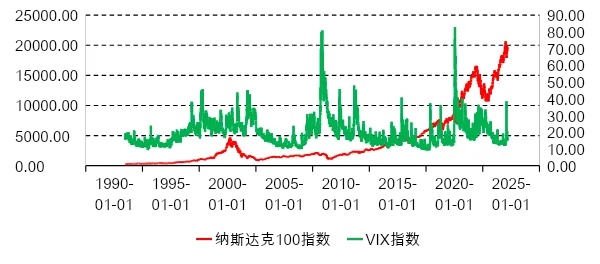At the beginning of September, U.S. stocks fell again. It is worth noting that the Nasdaq index did not rise to the record high set on July 10, driven by the performance of large technology companies exceeding expectations in the second quarter and rising expectations of interest rate cuts by the Federal Reserve.
We believe that the market's hidden worries about U.S. economic growth have affected investor confidence. In addition, the uncertainty of the Federal Reserve's future interest rate cuts, the increasing capital expenditure burden of U.S. technology companies and the uncertainty of fiscal policy brought by the general election have also led to the short-term weakness of U.S. stocks, and there is a great risk of adjustment in U.S. stocks in the short term.
There are hidden worries in the US economy
Judging from the economic data, the U.S. economy shows no signs of recession for the time being, and the actual GDP growth rate in the second quarter exceeded expectations. Data released by the Bureau of Economic Analysis (BEA) of the U.S. Department of Commerce showed that the annualized real GDP of the U.S. in the second quarter was 3% quarter-on-quarter, exceeding the expected 2% and far exceeding the previous value of 1.4%; The actual year-on-year growth rate was 3.2%, 0.3 percentage points faster than the 2.9% in the first quarter.
However, there are hidden worries in the U.S. economy, and it is difficult to reverse the trend of economic slowdown in the future. The difference lies in the speed and duration of economic slowdown. From the perspective of consumption, in the second quarter, the rebound in the growth rate of U.S. consumer spending has a lot to do with the low unemployment rate, falling inflation, and falling U.S. dollar interest rates. However, consumer confidence in the United States has not yet been fully restored. In August, the University of Michigan consumer confidence index fell to the second lowest record of the year, and more cautious consumption habits and retailer performance in the United States declined.
Under high interest rates, the prosperity of the U.S. construction and real estate industry is still weak. The National Association of Home Builders (NAHB)-Wells Fargo Housing Market Index, which reflects builder sentiment, fell to 39 in August, the lowest since January this year and down from 50 in the same period last year.
If the number of new non-farm payrolls in the United States continues to decline in August, which will confirm that the weaker data in July is not only due to temporary factors, but reflects a real weakening of labor demand, it may bring similar shocks to the market in early August. The impact of a sharp decline. The VIX index, which reflects market panic, fell slightly after surging to 38 on August 5, but did not return to the low level before mid-July, which was 15.55 on September 2.
The picture shows the comparison of the trends of the Nasdaq 100 Index and the VIX Index

The Fed's path to cut interest rates is not clear
After Powell's Jackson Hole speech, it is a foregone conclusion that the Federal Reserve will cut interest rates in September, but there is great uncertainty about the extent and timing of future interest rate cuts. In terms of inflation, since the second quarter, U.S. inflation has continued to decline moderately, but the possibility of a rebound is not ruled out.
Looking back at the six interest rate cut cycles since 1984, the impact of interest rate cuts on U.S. stocks is that they first fell and then rose. The main logic is:
First, the Fed's interest rate cut is a confirmation of the slowdown of the U.S. economy, and the performance of U.S. listed companies is likely to weaken, resulting in U.S. stock valuations. downward. Second, the Fed's interest rate cut means that financing costs are reduced, and the return on investment in the stock market is higher than fixed income such as bonds.
U.S. election creates policy uncertainty
According to the four-factor model of U.S. stocks we built, in addition to economic growth, liquidity (interest rate) and profits of listed companies, there are also U.S. policies. Policy uncertainty will lead to a lack of confidence in the market and risk aversion. As Harris succeeded Biden and officially became the Democratic candidate, the U.S. election entered a white-hot stage.
To sum up, due to the hidden worries of the U.S. economy, the vulnerability of U.S. stocks is obvious. Although expectations for the Federal Reserve to cut interest rates are heating up, the path of interest rate cuts is not clear. Moreover, from historical experience, the impact of interest rate cuts on U.S. stocks is to fall first and then rise. What's more, this round of interest rate cuts may be preventive, and the magnitude of interest rate cuts will not be too large. In addition, the U.S. election has brought certainty to fiscal expansion policy.
$NQ100 Index Main 2409 (NQmain) $$SP500 Index Main 2409 (ESmain) $$Dow Jones Index Main 2409 (YMmain) $$Gold Main 2412 (GCmain) $$WTI Crude Oil Main 2410 (CLmain) $
Comments